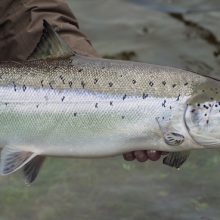This article may contain affiliate links. If you make a purchase after clicking on a link we may earn a small commission at no extra cost to you. As an Amazon Associate, I earn from qualifying purchases.
Drift Fishing for Salmon

Drift fishing is a great way to cover a lot of water along a particular stretch of river and it can give you a very natural presentation to your bait especially when drifting beads or eggs down river.
Some anglers do will use this technique to work an entire stretch of river seeking out various different seams, pockets, pools, tailouts, channels and any other structure that salmon are most likely to be found.
What is Drift Fishing ?
Drift fishing is a technique whereby you cast up stream of a pool or other holding area and allow your lure/bait to drift along with the current towards the spot that you are targeting.
You may also drift fish from an anchored boat which is a popular technique on large rivers.
The real trick to drift fishing is to use just enough weight on your rig so that the weight bounces about a foot or so every time it bounces down stream with the current.
Too much weight and it will stay in place and not travel very far from where you cast it.
Too little weight and your lure or bait will run too shallow in the water and they may pass right over the top of a waiting salmon who will most likely just ignore it.
Drift Fishing for Salmon
There are many salmon fishing river techniques that use weight to target salmon such as drift fishing, plunking, bottom bouncing and they are all good options depending on the situation.
Just like plunking for salmon drift fishing is all about getting your lure down to the right depth and right in front of a salmon, they do it in different ways but the end goal is always the same; put your lure right in front of a salmons mouth.
The real point to concentrate on with drift fishing is that you get your weight right relative to the current in the particular stretch of water that you are fishing.
Even on the same river I will switch out the weights depending on the current and one of the biggest mistakes I see is when an angler uses the exact same weight all day every day.
This is why using a slinky weight that has a snap link on it is important as you can change them out as quickly as you need to with no retying.
Cast you rig upstream and slight beyond the particular stretch you are looking to drift over.
Allow the weight to sink and then try to get a bit of feel back down through the rod as to whether or not it feels like it is bouncing correctly along the bottom of the river.
You may not always feel a bite as you will have some slack line in your system.
Other strikes however can be extremely violent and you will definitely now them when you feel them.
The best bait for salmon is good old fashioned eggs or skein after that I would look at things beads or yarn that will force a predatory strike.
Drift Fishing Setup
The drift fishing setup is fairly basic and once you have it configured it is very easy to adjust it for varying different currents depending on the river.
You’ll need a rod that is rated for at 20 to 25 lbs for larger Chinooks or 10 to 15 lbs for smaller species.
If using braid as your main line then you can double those numbers so 20 lbs mono main line is roughly the equivalent of 40 to 50 lbs braid.
Both a spinning or a casting rod drift setup will work just fine, however for larger salmon I always prefer a casting rod and reel as it handles bigger weights and fish better.
The best salmon fishing rod for drift fishing would be roughly 9’6″ with a medium of a medium/heavy power rating and a fast action.
A fast action will give you the necessary feedback through the rod tip.
Pair this with a high quality salmon fishing reel in either a size 4000 for a spinning reel or a 30 to 40 when sizing a baitcaster.
Tie a snap swivel to the end of your main line. From this attach a slinky style weight.
Slinky weights are better as their thin profile lessens the chances of them snagging on small rocks of submerged branches when compared to round or pyramid style weights.
Then tie a leader of roughly 36 inches in length of 15 to 20 lbs mono to the other eye of the swivel.
The snap link should be free to hang naturally off of the swivel.
